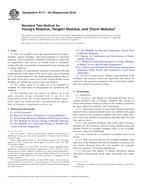Wir benötigen Ihre Einwilligung zur Verwendung der einzelnen Daten, damit Sie unter anderem Informationen zu Ihren Interessen einsehen können. Klicken Sie auf "OK", um Ihre Zustimmung zu erteilen.
ASTM E111-04(2010)
Standard Test Method for Young´s Modulus, Tangent Modulus, and Chord Modulus
Automatische name übersetzung:
Standardtestverfahren für E-Modul, Tangentenmodul und Chord Modulus
NORM herausgegeben am 15.9.2010
Informationen über die Norm:
Bezeichnung normen: ASTM E111-04(2010)
Anmerkung: UNGÜLTIG
Ausgabedatum normen: 15.9.2010
SKU: NS-40465
Zahl der Seiten: 7
Gewicht ca.: 21 g (0.05 Pfund)
Land: Amerikanische technische Norm
Kategorie: Technische Normen ASTM
Kategorie - ähnliche Normen:
Die Annotation des Normtextes ASTM E111-04(2010) :
Keywords:
chord modulus, stress-strain diagram, tangent modulus, Young´s modulus, Chord modulus, Stress--metallic materials, Stress-strain testing, Structural metals/alloys, Tangent modulus, Young&apos,s modulus, ICS Number Code 77.040.10 (Mechanical testing of metals)
Ergänzende Informationen
| Significance and Use | ||||||||||||||||||
|
The value of Young's modulus is a material property useful in design for calculating compliance of structural materials that follow Hooke's law when subjected to uniaxial loading (that is, the strain is proportional to the applied force). For materials that follow nonlinear elastic stress-strain behavior, the value of tangent or chord modulus is useful in estimating the change in strain for a specified range in stress. Since for many materials, Young's modulus in tension is different from Young's modulus in compression, it shall be derived from test data obtained in the stress mode of interest. The accuracy and precision of apparatus, test specimens, and procedural steps should be such as to conform to the material being tested and to a reference standard, if available. Precise determination of Young's modulus requires due regard for the numerous variables that may affect such determinations. These include (1) characteristics of the specimen such as orientation of grains relative to the direction of the stress, grain size, residual stress, previous strain history, dimensions, and eccentricity; (2) testing conditions, such as alignment of the specimen, speed of testing, temperature, temperature variations, condition of test equipment, ratio of error in applied force to the range in force values, and ratio of error in extension measurement to the range in extension values used in the determination; and (3) interpretation of data (see Section 9). When the modulus determination is made at strains in excess of 0.25 %, correction should be made for changes in cross-sectional area and gage length, by substituting the instantaneous cross section and instantaneous gage length for the original values. Compression results may be affected by barreling (see Test Methods E9). Strain measurements should therefore be made in the specimen region where such effects are minimal. |
||||||||||||||||||
| 1. Scope | ||||||||||||||||||
|
1.1 This test method covers the determination of Young's modulus, tangent modulus, and chord modulus of structural materials. This test method is limited to materials in which and to temperatures and stresses at which creep is negligible compared to the strain produced immediately upon loading and to elastic behavior. 1.2 Because of experimental problems associated with the establishment of the origin of the stress-strain curve described in 8.1, the determination of the initial tangent modulus (that is, the slope of the stress-strain curve at the origin) and the secant modulus are outside the scope of this test method. 1.3 The values stated in SI units are to be regarded as standard. No other units of measurement are included in this standard. 1.4 This standard does not purport to address all of the safety concerns, if any, associated with its use. It is the responsibility of the user of this standard to establish appropriate safety and health practices and determine the applicability of regulatory requirements prior to use. |
||||||||||||||||||
| 2. Referenced Documents | ||||||||||||||||||
|
Ähnliche Normen:
Historisch
1.6.2010
Historisch
1.8.2014
Historisch
15.11.2012
Historisch
15.11.2012
Historisch
15.6.2009
Historisch
1.7.2010
Empfehlungen:
Aktualisierung der technischen Normen
Wollen Sie sich sicher sein, dass Sie nur die gültigen technischen Normen verwenden?
Wir bieten Ihnen eine Lösung, die Ihnen eine Monatsübersicht über die Aktualität der von Ihnen angewandten Normen sicher stellt.
Brauchen Sie mehr Informationen? Sehen Sie sich diese Seite an.



 ASTM E83-10a
ASTM E83-10a ASTM E831-14
ASTM E831-14 ASTM F1470-12
ASTM F1470-12 ASTM F1642-12
ASTM F1642-12 ASTM F1683-09
ASTM F1683-09 ASTM F1702-10
ASTM F1702-10
 Cookies
Cookies
